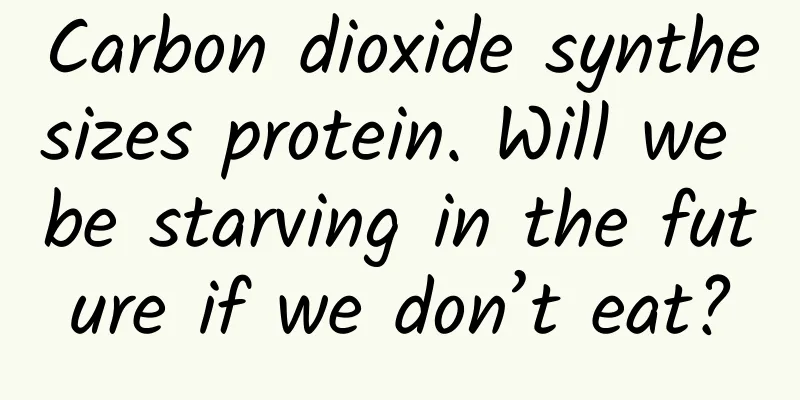Carbon dioxide synthesizes protein. Will we be starving in the future if we don’t eat?

|
Tuchong Creative I believe everyone is familiar with the saying "drinking northwest wind". It generally refers to people who are too poor to eat. However, in the future, this saying may be useless, because "drinking northwest wind" can really fill you up. Today we will talk about how to turn carbon dioxide into protein. We learned in biology class that plants can convert carbon dioxide and water in the air into starch through photosynthesis. So, can carbon dioxide also synthesize protein? At that time, the teacher did not say that carbon dioxide can also synthesize protein. Protein, as we all know, is an important foundation of life, and it has complex structure and function. Is it reliable to convert carbon dioxide into protein? It is reported that a factory in Finland has started to produce protein with carbon dioxide, and the annual output has reached 160 tons. What is 160 tons? This is equivalent to 22.85 million eggs (the protein content in one egg is about 7 grams), or 5,333 tons of milk (the protein content is about 3%). If each person needs 80 grams of protein per day, this output is enough to feed 5,500 people for a year. These data may be exaggerated, but this technology is not new. my country is also conducting relevant research. In September 2021, the Tianjin Institute of Industrial Biotechnology of the Chinese Academy of Sciences first realized the artificial synthesis of carbon dioxide to starch. In the same year, the Feed Research Institute of the Chinese Academy of Agricultural Sciences also announced that it used industrial exhaust gas containing carbon monoxide and carbon dioxide and ammonia water as the main raw materials to produce a new feed protein resource, ethanol Clostridium protein. With all the excitement, how is protein synthesized using carbon dioxide? Although protein has a complex structure, it is mainly composed of carbon, hydrogen, oxygen, nitrogen, and a small amount of sulfur, phosphorus and other elements. The largest amount of these two elements are carbon and oxygen, and carbon dioxide happens to be composed of these two elements. By electrolyzing water to obtain a certain amount of hydrogen and oxygen, the basic raw materials are almost there. Then, add all these raw materials into the fermentation tank and add specific fermentation bacteria, such as nitrogen-fixing bacteria, ethanol Clostridium, etc., and leave the rest to time. The whole process is a bit similar to beer fermentation. However, this method only produces a mixture of proteins, of which about 60% to 80% is protein. By repeatedly separating and purifying this mixture, protein powder can be obtained. You may ask: What is the advantage of this method? Is the protein obtained the same as the protein we usually eat? Let's talk about the advantages first. The first advantage is high production efficiency. Compared with the traditional method of obtaining protein through planting and breeding, the production efficiency of protein synthesis from carbon dioxide can be increased by 300-2000 times. This is mainly because the growth and reproduction rate of microorganisms is fast, which can greatly shorten the production cycle. The second advantage is the high conversion efficiency. Previously, the Feed Research Institute of the Chinese Academy of Agricultural Sciences made a breakthrough in the core key technology of preparing ethanol Clostridium protein, achieving a major achievement of one-step biosynthesis of protein with a maximum yield of 85% from one carbon gas. This is nearly 10 times higher than the conversion efficiency of plant photosynthesis. In other words, consuming two tons of carbon dioxide can produce nearly one ton of protein. The third advantage is environmental protection. At present, we obtain protein mainly through planting and raising. Both methods require the consumption of a large amount of land, fossil fuels, fertilizers, pesticides and water. The production process of traditional protein not only releases a large amount of carbon dioxide, exacerbating the greenhouse effect, but also causes environmental pollution. Synthesizing proteins from carbon dioxide not only consumes carbon dioxide, but also requires less energy. The whole process, in theory, emits less than one percent of carbon dioxide compared to traditional methods. Of course, there is another advantage that we must mention, which is that its raw materials come from a wider range of sources. In addition to carbon dioxide in the air, agricultural waste such as straw, bagasse, beet pulp, as well as industrial waste, industrial and agricultural wastewater, crude oil, diesel, and waste gas can all be used as fermentation raw materials. The team of the Academy of Agricultural Sciences mentioned above uses industrial tail gas to achieve an annual production of 5,000 tons of protein for feed. Currently, only a few countries have approved the use of "air protein" in food production. For example, Singapore has made it into ice cream. From a purely nutritional point of view, there is not much difference between "air protein" and the protein in the food we eat now. However, there is a certain difference in taste. However, in the future, we can also adjust the amino acid composition of protein by changing the species and genes of fermentation bacteria to meet the needs of different groups of people. At present, the technology of synthesizing protein from carbon dioxide needs to be further improved, and there is still a long way to go before it can be truly applied on a large scale. However, this technology is no longer restricted by land, environment, rainfall and temperature. As long as there is energy, protein can be produced anywhere. Carbon dioxide protein synthesis technology can be used as an effective supplement to traditional industries to alleviate the food crisis. It can also enrich food types and produce emerging foods such as artificial meat, artificial milk, and plant-based foods. In addition, "carbon dioxide protein" can also be used in the fields of pharmaceutical industry, animal husbandry, and aerospace. Especially aerospace. This technology can provide a food basis for human space programs. Imagine that the most abundant thing in the atmosphere of Mars is carbon dioxide, with a proportion of up to 95%. Coupled with sufficient solar energy, it can provide the necessary protein for Mars immigrants. In addition, with this technology, in the future, when you travel in space and enjoy the vast beauty of the universe, you can also enjoy the "fresh" hamburgers and mapo tofu produced on the spacecraft at any time. What a wonderful life it will be. Author: Zhang Yu Reviewer: Song Yi, Associate Professor, College of Food Science and Nutritional Engineering, China Agricultural University Liang Qianjin, Professor, College of Life Sciences, Beijing Normal University Produced by: China Association for Science and Technology Department of Science Popularization Producer: China Science and Technology Press Co., Ltd., Beijing Zhongke Xinghe Culture Media Co., Ltd. |
<<: Glutinous or sweet? The "corn dispute" escalates again!
Recommend
The entire process of new product launch promotion plan!
Table of contents: Chapter 1: Industry Background...
iPhone 6 disassembly: No revolutionary changes, but easier to repair
On the evening of October 2nd, Beijing time, Bill...
Toutiao 2019-2020 Marketing Plan
About the marketing plan of Toutiao platform Tout...
Ajun's "Short Video Operation Course" systematic tutorial starting from scratch
Training course video content introduction: This ...
Another IPO, Nezha Auto's desperate attempt to go public may be due to a survival crisis
Have you ever seen someone who looks like he'...
6 ways to monetize community operations
I always encourage you to build communities becau...
How to successfully hold an Internet product launch conference?
The product has been quietly launched for a year ...
Color actually affects test scores? This is the best color for the walls of your child's study room
At the 2022 Beijing Winter Olympics, the red of t...
Apple mobile game development tools: GameplayKit development guide
At the WWDC 2015 conference held in the early mor...
Why do Android devices become stuck after being used for a long time and Apple devices crash after being used for a long time?
Generally, after using a mobile phone for about t...
How do new media operators choose promotion channels?
Recently, I saw a very thought-provoking question...
Four marketing techniques for jewelry industry on Xiaohongshu
Some time ago, a friend of mine on Xiaohongshu to...
How to create a hit product on Xiaohongshu? Xiaohongshu’s hot-selling guide!
As a gathering place for the new generation of co...
Practical tips for app promotion! App Marketing Strategy
1. Overall Logic There is only one logic in runni...
The bonus period of Douyin fans is coming, how can we take advantage of it?
Follow the flow , you will never go wrong. This s...









